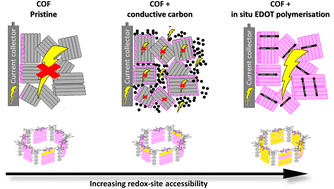Redox-site accessibility of composites containing a 2D redox-active covalent organic framework: from optimization to application†‡
Abstract
Redox-active covalent organic frameworks (RACOFs) can be employed in various functional materials and enesrgy applications. A crucial performance or efficiency indicator is the percentage of redox centres that can be utilised. Herein, the term redox-site accessibility (RSA) is defined and shown to be an effective metric for developing and optimising a 2D RACOF (viz., TpOMe-DAQ made from 2,4,6-trimethoxy-1,3,5-benzenetricarbaldehyde [TpOMe] and 2,6-diaminoanthraquinone [DAQ]) as an anode material for potential organic-battery applications. Pristine TpOMe-DAQ utilises only 0.76% of its redox sites, necessitating the use of conductivity-enhancement strategies such as blending it with different conductive carbons, or performing in situ polymerisation with EDOT (3,4-ethylenedioxythiophene) to form a conductive polymer. While conductive carbon-RACOF composites showed a modest RSA improvement of 4.0%, conductive polymer-RACOF composites boosted the redox-site usage (RSA) to 90% at low mass loadings. The material and electrochemical characteristics of the conductive polymer-RACOF composite containing more-than-necessary conductive polymer showed a reduced surface area but almost identical electrochemical behaviour, compared to the optimal ratio. The high RSA of the optimally loaded composite was replicated in a RACOF-air battery with over 90% active redox sites. We believe that the reported approach and methods, which can be employed on a milligram scale, could serve as a general guide for the electrification and characterisation of RACOFs, as well as for other redox-active porous polymers.



 Please wait while we load your content...
Please wait while we load your content...